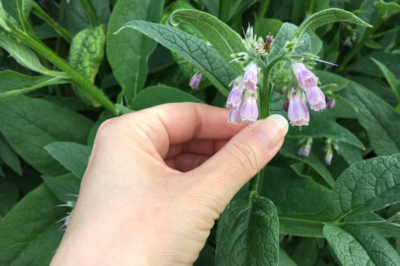Comfrey is a versatile plant of the native flora, which can be harvested three to five times a year. Leaves, flowers and roots are used for medicinal purposes or for the preparation of food and drink.

Spring
Comfrey shows itself in spring by slightly hairy leaves with wavy edges. Typical is the coarse veining on the surface of the leaves. Although the useful plant has few healthy ingredients at this time, the fresh leaflets are suitable for harvesting. They are tender and can be used in a variety of ways in raw salads, or processed into vegetables.
Dry leaves
If you want to dry comfrey and use it later, you should not wait too long to harvest it. The foliage has the greatest content of valuable ingredients shortly before flowering. As soon as the first stems appear, the concentration of active ingredients drops. The plant now puts its energy into developing the flowers.
Harvesting blossoms
The flowering period of the comfrey begins in May. The flower buds are separated and cooked like vegetables. They go great with dandelion buds. When the plant is in full bloom, it decorates the landscape with bluish and purple hues. The petals of the crown are suitable for edible decoration and decorate raw vegetable platters or salads. So that the beauty does not fade, you should not wash the collected flowers.
Summer
The plant continuously forms fresh shoots for collection. But over time, the leaves, up to 60 centimeters long, become coarser and are no longer suitable for consumption. The foliage contains a list of health-promoting substances such as potassium, phosphorus, calcium, and vitamins A, C and B12. Remarkable is the protein content, which is not surpassed by any other plant.
Summer leaves are suitable:
- as a material for the production of liquid manure for tomatoes and potatoes
- in withered form for mulching
- as a golden yellow textile dye when leaves are soaked in boiling water
Autumn
Starting in September, you can dig up and harvest the roots. Select strong growing specimens and cut off only enough of the rhizome so that the plant can continue to grow. They are suitable for consumption in the raw or cooked state and provide a coffee substitute when dried and roasted.

